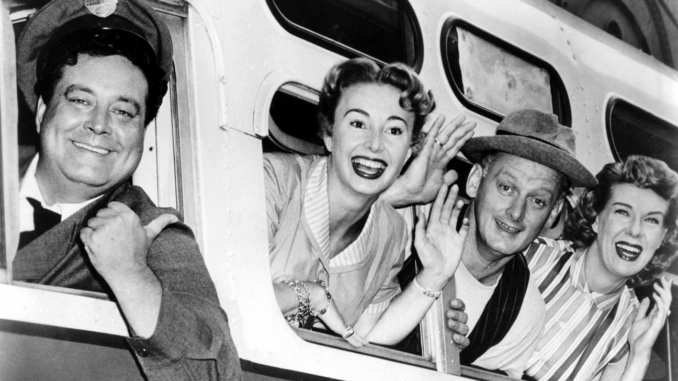
When The Honeymooners first aired in 1955, no one could have guessed that a simple, black-and-white show about a Brooklyn bus driver and his sharp-witted wife would go on to define television comedy for generations. Running for just one full season — the now-iconic “Classic 39” episodes — The Honeymooners left an impact on American pop culture far greater than many shows that lasted for decades. Its influence reshaped the DNA of sitcoms, setting a model for realism, humor, and human imperfection that remains relevant to this day.
Breaking Away from the Dream: Realism in a Fantasy Era
In the 1950s, American television was dominated by idealized portrayals of middle-class family life. Shows like Father Knows Best and Leave It to Beaver projected a clean, suburban dream where fathers were wise, mothers were patient, and children were perfectly behaved. The Honeymooners shattered that illusion. Jackie Gleason’s Ralph Kramden was no perfect husband or father — he was loud, short-tempered, insecure, and perpetually broke. His wife Alice, played by Audrey Meadows, wasn’t a passive homemaker but a witty, no-nonsense woman who stood her ground.
Their small Brooklyn apartment, bare and modest, became a stage for working-class frustration and aspiration. Ralph’s famous get-rich-quick schemes always failed, but his dreams — of success, respect, and happiness — reflected something deeply human. For millions of viewers living paycheck to paycheck, Ralph and Alice Kramden were not caricatures. They were real.
This grounding in reality was revolutionary for its time. The laughter didn’t come from silly misunderstandings or slapstick alone, but from the emotional truth of everyday life — from arguments, hopes, and the constant struggle to “make it.” That realism would later become the cornerstone of television comedy.
A Blueprint for Generations: The Ripple Effect of The Honeymooners

Perhaps the most visible echo of The Honeymooners came in The Flintstones, the world’s first prime-time animated sitcom. When The Flintstones premiered in 1960, audiences immediately noticed the resemblance: Fred Flintstone and Barney Rubble were practically animated versions of Ralph Kramden and Ed Norton. Wilma and Betty mirrored Alice and Trixie, grounding their husbands’ foolish antics with humor and common sense.
The similarities were so striking that Jackie Gleason allegedly considered suing Hanna-Barbera for plagiarism. But he reportedly backed down, fearing public backlash — as no one wanted to be remembered as “the man who killed The Flintstones.” Instead, the animated homage became further proof of The Honeymooners’ enormous cultural reach.
The influence didn’t stop there. In the 1970s, Norman Lear’s All in the Family took Gleason’s model of domestic conflict and political tension to new heights. Archie Bunker, like Ralph Kramden, was a working-class man with big opinions, quick temper, and a deep, if hidden, love for his family. Decades later, Roseanne would carry the same torch — blending comedy, class consciousness, and raw family realism into a modern format.
The Power of Four: A New Sitcom Structure
Another hallmark innovation of The Honeymooners was its tight focus on a small, recurring cast — the now-classic “four-character core.” Ralph and Alice Kramden, alongside Ed and Trixie Norton, formed an intimate world that allowed audiences to grow attached to each relationship dynamic.
This structure offered balance: two couples, two perspectives, and four personalities constantly colliding. It became a model for countless future sitcoms — from I Love Lucy and Three’s Company to Friends and Seinfeld. The “four-person formula” gave writers narrative flexibility while keeping the audience emotionally invested in a familiar, small universe.
Working-Class Heroes: Laughter from Struggle
One of The Honeymooners’ most enduring contributions was its ability to find humor in hardship. Ralph’s endless optimism in the face of constant failure turned despair into comedy — not by mocking poverty, but by celebrating perseverance. His catchphrase, “One of these days, Alice — POW! Right in the kisser!” — though exaggerated — symbolized the emotional chaos of marriage, yet always ended in reconciliation. Beneath the shouting and schemes lay deep affection and loyalty.
The show taught audiences that laughter could coexist with frustration, that imperfection was not failure but humanity. This theme carried through decades of sitcoms, shaping shows such as The King of Queens, where Kevin James’ Doug Heffernan served as a modern-day Ralph Kramden. Doug’s blue-collar life, sarcastic wife, and loyal sidekick Arthur were direct descendants of the world Jackie Gleason created in the 1950s.
A Legacy Beyond Its Time
Despite its short run, The Honeymooners became a cultural blueprint. It proved that comedy could come from truth, not fantasy — from broken dreams, not perfection. Its influence can be felt in nearly every major sitcom that values character-driven storytelling and social realism.
What makes The Honeymooners timeless is not just its jokes, but its heart. Ralph Kramden’s constant striving — his desperate, foolish, and beautiful belief that tomorrow could be better — continues to echo through television’s best characters. From Archie Bunker to Homer Simpson, from Roseanne Conner to Doug Heffernan, the spirit of Ralph and Alice Kramden lives on.
As television evolves, the lessons of The Honeymooners remain constant: great comedy comes not from glamour, but from grit; not from perfection, but from people. And sometimes, it only takes 39 episodes to change the world.
